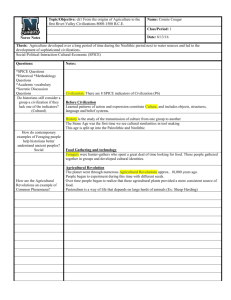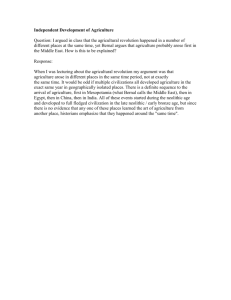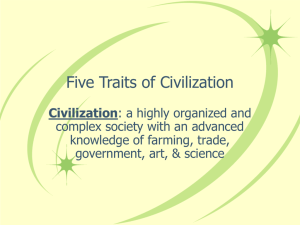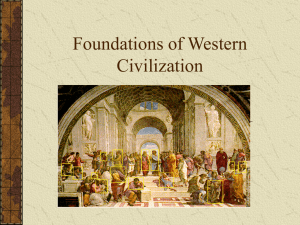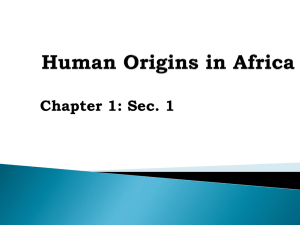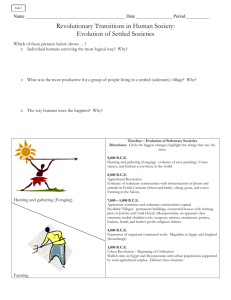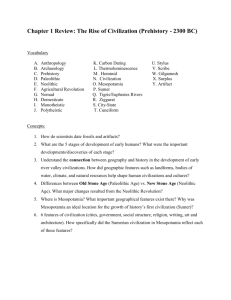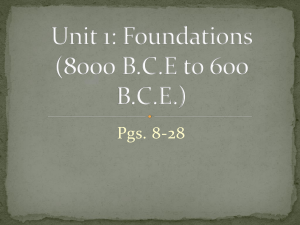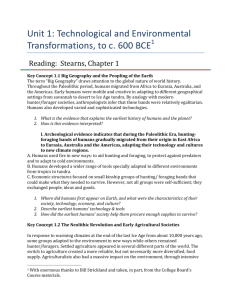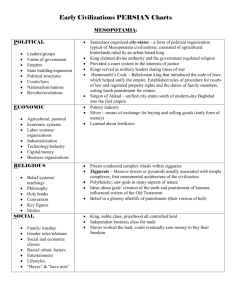Example Summary Notes Chapter 1 Form the origins of Agriculture
advertisement
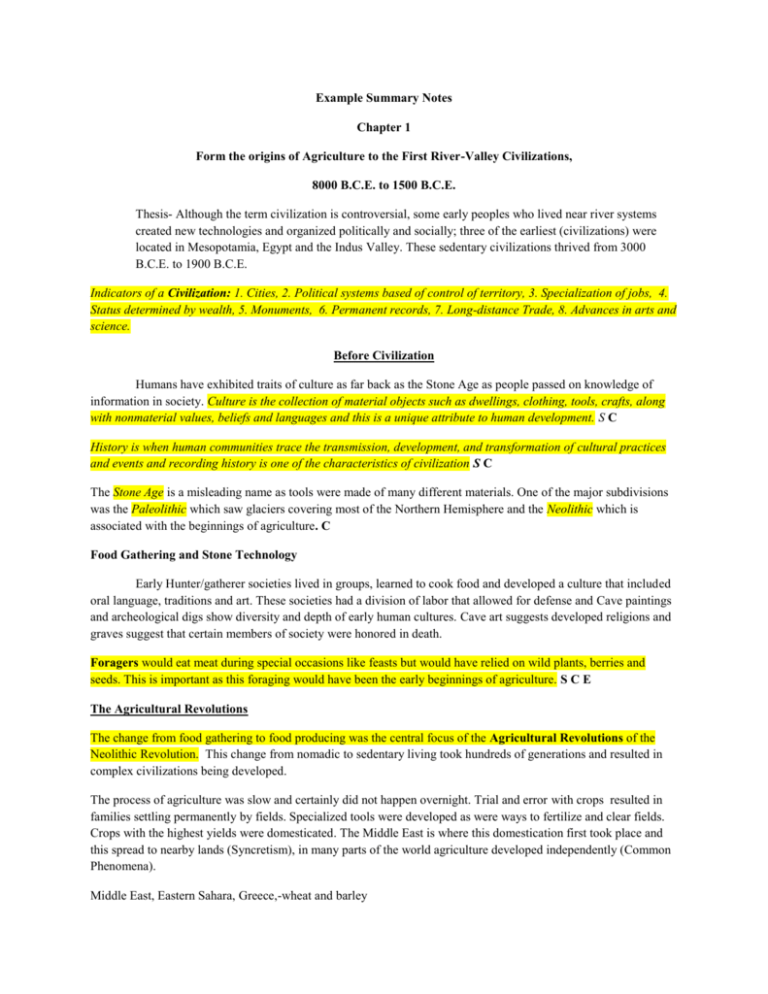
Example Summary Notes Chapter 1 Form the origins of Agriculture to the First River-Valley Civilizations, 8000 B.C.E. to 1500 B.C.E. Thesis- Although the term civilization is controversial, some early peoples who lived near river systems created new technologies and organized politically and socially; three of the earliest (civilizations) were located in Mesopotamia, Egypt and the Indus Valley. These sedentary civilizations thrived from 3000 B.C.E. to 1900 B.C.E. Indicators of a Civilization: 1. Cities, 2. Political systems based of control of territory, 3. Specialization of jobs, 4. Status determined by wealth, 5. Monuments, 6. Permanent records, 7. Long-distance Trade, 8. Advances in arts and science. Before Civilization Humans have exhibited traits of culture as far back as the Stone Age as people passed on knowledge of information in society. Culture is the collection of material objects such as dwellings, clothing, tools, crafts, along with nonmaterial values, beliefs and languages and this is a unique attribute to human development. S C History is when human communities trace the transmission, development, and transformation of cultural practices and events and recording history is one of the characteristics of civilization S C The Stone Age is a misleading name as tools were made of many different materials. One of the major subdivisions was the Paleolithic which saw glaciers covering most of the Northern Hemisphere and the Neolithic which is associated with the beginnings of agriculture. C Food Gathering and Stone Technology Early Hunter/gatherer societies lived in groups, learned to cook food and developed a culture that included oral language, traditions and art. These societies had a division of labor that allowed for defense and Cave paintings and archeological digs show diversity and depth of early human cultures. Cave art suggests developed religions and graves suggest that certain members of society were honored in death. Foragers would eat meat during special occasions like feasts but would have relied on wild plants, berries and seeds. This is important as this foraging would have been the early beginnings of agriculture. S C E The Agricultural Revolutions The change from food gathering to food producing was the central focus of the Agricultural Revolutions of the Neolithic Revolution. This change from nomadic to sedentary living took hundreds of generations and resulted in complex civilizations being developed. The process of agriculture was slow and certainly did not happen overnight. Trial and error with crops resulted in families settling permanently by fields. Specialized tools were developed as were ways to fertilize and clear fields. Crops with the highest yields were domesticated. The Middle East is where this domestication first took place and this spread to nearby lands (Syncretism), in many parts of the world agriculture developed independently (Common Phenomena). Middle East, Eastern Sahara, Greece,-wheat and barley China, India-Rice Americas- Maize (corn) Domesticated animals played a significant role in sedentary life providing meat, milk, fertilizer and skins for people. As time went on, people of AfroEurAsia adapted animals to be used for agricultural labor and transport of goods. This facilitated the diffusion of food, ideas and religion in this region. In the Americas there were few animals suited to domestication, which led to less trade amongst the Amerindians as well as distinct, isolated groups based on geographic position. There are numerous theories as to what drove these agricultural revolutions. (Holocene Era) Climate change may have been a big part though increases in the human population may have necessitated agriculture in favor of food gathering. Still, many may have seen the advantages of agriculture. (BP) What events led to the development of agriculture during the Neolithic Revolution? Life in Neolithic Communities Early Neolithic farmers had to work very hard but as time went on they learned new techniques to make life easier. As the food supply became more dependable specialized jobs became more abundant. As populations increased in size, they had to move farther away necessitating the creation of new settlements. Familiar family structures (both nuclear and extended) would have developed at this time. Religion focused on reverence of ancestors and centering on the “Earth Mother” deity which promoted agriculture. Megaliths were religious structures built to display the prominence of societies ranging from burial chambers in Egypt to Stonehenge in England. These Megaliths served ritual and symbolic functions for ancient societies. Catal Huyuk serves as an example of one of the earliest cities with many characteristics of culture as we think of it. Mesopotamia Babylon- Most important city of Southern Mesopotamia this city was characterized Settled Agriculture in an unstable landscape People settled and farmed between the Tigris and Euphrates rivers. The dry climate required irrigation and the use of beasts of burden. The beginnings of history for Mesopotamia begin with the Sumerians, who created the first writing system and the initial civilization of the region. By 2900 B.C.E. other Semitic peoples such as the Hebrew, Aramaic and Phoenicians began recording history. These people lived in peace with the Sumerians but as time went on the Sumerians adopted many elements of other cultures (Synthesis). Cities, Kings and Trade As villages grew and expanded, cities developed. Jobs became specialized (Metal workers, priests, etc.). Cities collected surplus crops and protected surrounding people from bandits. A self-governing urban center and surrounding agricultural areas are called a city-state. City states were earliest examples of civilization during the Agricultural revolutions. Building projects for Mesopotamians ranged from irrigation canals and dams to temples. Some of the earliest literature developed at this time (Epic of Gilgamesh), showing the sophistication of the belief system and cultural values of the people. As time went on some city-states began to dominate others and establish empires. One of these groups were the Amorites who established a new city at Babylon. One leader who emerged from this dynasty was Hammurabi, who developed an extensive series of laws that decided punishments for crimes as well as monetary penalties. This written law served as an example illustrating principles to be used in deciding cases.
